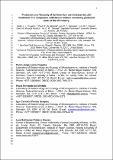Files in this item
Production and viscosity of Xanthan gum are increased by LED irradiation of X. campestris cultivated in medium containing produced water of the oil industry
Item metadata
| dc.contributor.author | Crugeira, P | |
| dc.contributor.author | de Almeida, P | |
| dc.contributor.author | Sampaio, I | |
| dc.contributor.author | Soares, L | |
| dc.contributor.author | Amador, D | |
| dc.contributor.author | Samuel, Ifor David William | |
| dc.contributor.author | Persheyev, Saydulla | |
| dc.contributor.author | Silveira Jr, L | |
| dc.contributor.author | Pinheiro, A | |
| dc.date.accessioned | 2022-11-12T00:59:07Z | |
| dc.date.available | 2022-11-12T00:59:07Z | |
| dc.date.issued | 2021-11-12 | |
| dc.identifier | 276713003 | |
| dc.identifier | 8bbfcacf-6aa2-4bfc-8619-cb02d7547e23 | |
| dc.identifier | 85119359446 | |
| dc.identifier | 000744263200001 | |
| dc.identifier.citation | Crugeira , P , de Almeida , P , Sampaio , I , Soares , L , Amador , D , Samuel , I D W , Persheyev , S , Silveira Jr , L & Pinheiro , A 2021 , ' Production and viscosity of Xanthan gum are increased by LED irradiation of X. campestris cultivated in medium containing produced water of the oil industry ' , Photochemistry and Photobiology , vol. In Press , 112356 . https://doi.org/10.1016/j.jphotobiol.2021.112356 | en |
| dc.identifier.issn | 0031-8655 | |
| dc.identifier.uri | https://hdl.handle.net/10023/26381 | |
| dc.description | Petrogal Brasil S.A., through the project “Sustainable biotechnological alternatives to increase the oil recovery factor of carbonate reservoirs” under the management of Instituto de Petróleo e Gás – ISPG and the National Agency of Petroleum, Natural Gas and Biofuels (ANP) provided financial support and grants to PJLG, PFA, ICFS, and ALBP, IDWS, Conselho Nacional de Desenvolvimento Cientifico e Tecnologico -CNPq provided a grant to LSF, and SP had financial support and grant from the Scottish Funding Council Global Challenges Research Fund. | en |
| dc.description.abstract | Oil recovery is a challenge and microbial enhanced oil recovery is an option. We theorized that the use of produced water (PW) with photo-stimulation could influence both production and viscosity of Xanthan gum. This study aimed at the evaluation of the effect of photo-stimulation by λ630 ± 1 ηm LED light on the biosynthesis of Xanthan gum produced by Xanthomonas campestris IBSBF 2103 strain reusing PW of the oil industry. We assessed the effect of photo-stimulation by LED light (λ630 nm) on the biosynthesis of Xanthan gum produced by X. campestris in medium containing produced water. Different energy densities applied during the microbial growth phase were tested. The highest production was achieved when using 12 J/cm2 LED light (p<0.01). Three protocols were assessed: Non-irradiated (Control), Irradiation with LED light during the growth phase (LEDgrowth) and Irradiation with LED light during both growth and production phases (LED growth+production). Both the amount and viscosity of the xanthan gum was significantly higher (p<0.01) in the group LEDgrowth+production. The study showed that LED irradiation (λ630 ± 1 ηm) during both the growth and production phases of the biopolymer increased both the production and viscosity of Xanthan gum. | |
| dc.format.extent | 924387 | |
| dc.language.iso | eng | |
| dc.relation.ispartof | Photochemistry and Photobiology | en |
| dc.subject | Photo-stimulation | en |
| dc.subject | Thermoplastic property | en |
| dc.subject | Biopolymer | en |
| dc.subject | MEOR | en |
| dc.subject | QD Chemistry | en |
| dc.subject | NDAS | en |
| dc.subject.lcc | QD | en |
| dc.title | Production and viscosity of Xanthan gum are increased by LED irradiation of X. campestris cultivated in medium containing produced water of the oil industry | en |
| dc.type | Journal article | en |
| dc.contributor.institution | University of St Andrews. Centre for Biophotonics | en |
| dc.contributor.institution | University of St Andrews. Condensed Matter Physics | en |
| dc.contributor.institution | University of St Andrews. School of Physics and Astronomy | en |
| dc.identifier.doi | 10.1016/j.jphotobiol.2021.112356 | |
| dc.description.status | Peer reviewed | en |
| dc.date.embargoedUntil | 2022-11-12 |
This item appears in the following Collection(s)
Items in the St Andrews Research Repository are protected by copyright, with all rights reserved, unless otherwise indicated.

